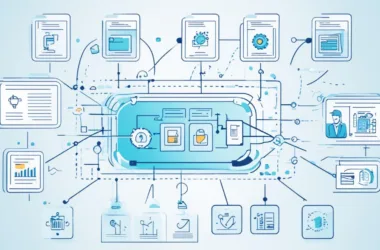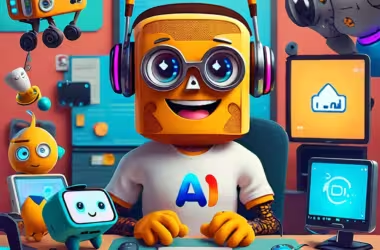As AI grows, it comes with many possibilities. But, we can’t ignore the ethical side. Bias and discrimination in AI systems are major concerns. Let’s look at how bias sneaks into AI and ways to fix it.
This article focuses on AI’s ethical issues, especially bias and discrimination. We’ll see how biased ideas in creating algorithms and using unfair data lead to biased results. Join us to learn about the factors and actions to reduce AI bias.
Key Takeaways:
- Ethical considerations in AI include the presence of bias and discrimination within AI systems.
- Bias in AI can occur due to biased assumptions in algorithm development or prejudices in the training data.
- Understanding the factors contributing to bias in AI systems is essential for effective mitigation.
- Implementing entity-level and process-level controls can help address bias in AI development.
- Addressing bias and discrimination in AI systems is critical for responsible and ethical AI deployment.
Understanding Bias in AI Systems
Bias in AI occurs from biased algorithm development and prejudices in training data. This can lead to unequal data consideration, favoring some over others. Such bias impacts decision-making and can increase unfairness and discrimination.
In the real world, AI bias shows up in various ways. For instance, some recruiting tools may prefer certain candidates due to biased algorithms. Racist comments from AI on social platforms show these embedded prejudices. Also, some facial recognition tools and image-cropping algorithms favor White faces, showing AI’s built-in biases.
To tackle AI bias, we must understand how it happens. This means looking closely at data input and algorithm design. By fixing biased AI algorithms and using diverse data, we can lower AI system biases.
Bias in AI occurs when there is unequal consideration of two data sets, often due to biased assumptions in the algorithm development process or prejudices in the training data.
Let’s discuss facial recognition as an example of AI bias. Studies show many facial recognition tools make more mistakes with darker skin tones than lighter ones. This design flaw can wrongly target individuals because of their skin color.
Addressing Bias in AI Systems
To reduce AI bias, we need a multi-step plan that includes:
- Reviewing and checking AI algorithms and models for bias
- Encouraging diverse AI development teams for broader viewpoints
- Setting up strong testing to find and fix biases
- Increasing AI system transparency to understand bias origins
Summary
Bias in AI stems from biased development and data prejudices. It causes unequal data treatment, leading to discrimination and unfairness. Recognizing and addressing AI system bias is key. With strategies to lessen bias, we can aim for fair and equitable AI systems.
Factors Contributing to Bias in AI Systems
Both external and internal things can make AI systems bias. It’s important to know and tackle these things. This helps keep AI fair and unbiased. Let’s look into some examples:
External Factors Causing Bias in AI
- Biased Real-World Data: AI can be unfair if it learns from real-world data that already has biases, like social inequalities.
- Lack of Guidance for Bias Identification: Developers might find it hard to spot and fix bias in AI without clear instructions.
- Biased Third-Party AI Systems: Using AI solutions from others can bring biases into an organization’s own AI systems.
Internal Factors Causing Bias in AI
- Lack of Focus on Bias Identification: If developers don’t specifically look for bias, they might miss it in their AI systems.
- Nondiverse Teams: AI teams without diversity might not see biases, leading to unfair decisions.
- Nonidentification of Sensitive Data Attributes: Not noticing sensitive info in training data can make AI biased.
- Unclear Policies: Without clear rules for AI development, accidental biases can creep in or not be properly addressed.
To avoid bias in AI, organizations should address these issues. This ensures AI technology is fair and ethical.
Mitigating Bias in AI Systems
Organizations can add processes and controls to make AI systems fairer. They aim to make sure AI is built and used ethically.
Entity-Level Controls for Bias in AI
Setting up AI rules at the entity level is key for control. These rules guide ethical AI making and stress on bias reduction. Clear rules and accountability help ensure fairness in AI systems.
Promoting Diversity and Culture of Ethics
A mix of views and people is vital to prevent bias in AI. A strong ethical culture promotes discussion on bias. This makes sure AI teams include diverse backgrounds for fairer AI.
Process-Level Controls for Bias in AI
It’s important to define what fairness in AI means. Organizations should make fairness criteria clear for everyone. They must look at AI’s impact on different groups to avoid reinforcing biases.
Organizations must prepare a balanced data set to fight AI bias. Diverse group representation in data reduces skewed AI results. Including varied ages, races, and genders makes AI systems more equal.
For fairness, reviewing AI decisions is crucial. Organizations need to check their decision-making for biases. They must ensure data, algorithms, and models are ethical and don’t single out any group.
Mitigating bias in AI takes a broad approach. It combines rules, ethics, and balanced processes. With these steps, organizations can make AI that’s fair and unbiased.
The Growing Impact of AI in Recruitment
AI has changed how we hire people, making things faster and smarter. It helps businesses make better choices and work more smoothly. But, we must deal with biases in AI to keep hiring fair.
Biases in AI can lead to unfair hiring based on things like gender or race. This makes inequality worse and can stop a workplace from being diverse and inclusive.
To fight these biases, we need to look into both tech and management fixes. For tech, we need to design algorithms that avoid bias. We also need data to help us make fair choices.
On the management side, having strong policies is key for using AI the right way. This means having diverse hiring teams and ways to spot and fix biases in AI.
By tackling these biases, businesses can use AI to improve hiring. They can be fairer, more diverse, and offer equal chances to everyone.
Impact of AI in the Hiring Process
AI changes hiring in many ways, helping both employers and job seekers. Here’s how AI has reshaped recruitment:
- Improved Efficiency: AI helps screen resumes and match candidates quickly, saving recruiters time for more important tasks.
- Enhanced Decision-Making: AI can look at lots of data to give insights. This helps recruiters pick the best candidates.
- Reduced Bias: AI can help reduce human biases in hiring. With the right algorithms and data, unfair practices can decrease.
- Streamlined Candidate Experience: AI tools like chatbots make talking to candidates faster and more personal. This makes a company look good to job seekers.
To make the most of AI in hiring, companies must handle the ethical issues around bias. By using both tech and management strategies, they can use AI well and keep hiring fair and diverse.
Algorithmic Bias in AI-Enabled Recruitment
Algorithmic bias is a big challenge in AI-enabled recruitment. It can come from different sources. These include limited or biased data sets and the biases of the algorithm designers.
Biased raw data sets: When AI algorithms are trained with limited or biased data, they make biased decisions. If the training data does not represent everyone fairly, AI might keep old biases. This can lead to unfair outcomes in hiring.
Biased algorithm designers: The people who make the algorithms can also cause bias. If they have their own biases, the AI might too. This can accidentally make hiring practices unfair.
To fight algorithmic bias in hiring, we need both tech and management solutions.
Technical measures: We should make AI algorithms clearer and fix biased data sets. Using fair data and being open about how AI works can help fix biases in hiring.
Management measures: On the management side, stopping AI discrimination is key. Things like ethical rules inside companies and oversight from outside can keep AI hiring fair and unbiased.
These steps work together to reduce bias in AI hiring. They help make sure everyone has a fair chance.
The Role of AI in Small Business Transformation
Artificial Intelligence (AI) is changing the game for small businesses. It brings benefits that can change how they work and grow. Small business owners can now understand sales trends and cash flow better, without extra staff or becoming experts in finance.
AI gives small business owners precise, current financial details. It looks at huge data sets to spot patterns and trends. This allows owners to make swift, smart decisions for better profits.
Getting access to capital is key for small businesses to grow. AI is changing how creditworthiness is judged, making it faster and more correct. This means fair chances for small businesses to get the money they need to grow.
Also, AI can do routine jobs, saving time and making things run smoother. From chatbots for customers to managing stock, AI tools help cut costs and let businesses do more important work.
AI has changed how small businesses work, giving them valuable insights and better decision power. It levels the playing field, letting small businesses take on bigger ones and grow.
The Benefits of AI for Small Businesses
Small businesses can use AI to stay competitive and grow. AI brings many benefits to them, like:
- Improved decision-making: AI gives data insights, helping owners make better business choices.
- Efficient operations: AI takes over repeat tasks, boosting how well operations run.
- Enhanced customer experience: AI chatbots and virtual helpers offer personalized customer care, making experiences better.
- Increased productivity: AI deals with time-taking tasks, letting owners and staff work on growth-driving activities.
- Cost savings: AI helps make processes better, cuts mistakes, and lowers waste, saving money for small businesses.
As AI tech gets better, small businesses have a big chance to use its power for long-term success. By using AI, they can discover new insights, work more efficiently, and make more profit, helping them stand out in a tough business world.
Ethical Concerns in the Age of AI
The rise of AI brings up ethical issues like privacy, surveillance, and bias. It also questions the social effect of AI on us.
AI can collect and use a lot of personal data. This makes us worry about our privacy and unwanted surveillance.
AI helps in making decisions, but relying too much on it raises questions. We wonder if it’s fair and free of biases.
It’s important to think about bias and fairness in AI. If not careful, AI might treat people unfairly based on race or gender.
AI can change society in big ways. However, this might make inequality worse, affecting some groups more than others.
To use AI right, we need to focus on ethics. This means making AI fair, open, and careful with personal data. It’s up to companies and rule-makers to do this.
To use AI right, we must handle issues like privacy and fairness. This ensures AI helps everyone in a good way.
Using AI wisely means thinking about ethics. We need rules and an open mindset. This helps make sure AI benefits everyone and does no harm.
When creating AI, we must aim for transparency and fairness. This tackles ethical issues, making AI helpful for society.
The Need for Ethical AI Standards and Guidelines
The creation of ethical AI standards and guidelines is key. They lead the way for AI that is developed and used responsibly. These rules help address issues like bias and discrimination, making sure AI technology is used ethically. They aim to protect individuals and society from harm.
Ethical AI standards urge organizations to create AI that is transparent, fair, and accountable. They help in making ethical choices during the development of AI technologies. This approach makes developers think about how their AI might affect ethical issues.
Following ethical AI standards builds trust with users and other important groups. It shows a commitment to ethics and responsible AI use. Organizations can lessen AI risks and reduce negative effects on people and society this way.
Furthermore, these standards give a plan for addressing bias and discrimination in AI systems. They push for the finding and lowering of biases as AI is being made. This ensures AI algorithms and models are fair and without bias.
With these guidelines, developers can face biases in AI head-on. They work to lessen the bad effects biases might have. This includes being careful with the data used, staying away from biased sources, and including different viewpoints. This helps understand potential biases better.
Benefits of Ethical AI Standards and Guidelines
The adoption of ethical AI standards and guidelines provides many advantages:
- It advances fairness and transparency in how AI makes decisions.
- It makes sure there is accountability for AI’s effects on people and society.
- It challenges biases and discrimination in AI algorithms and models.
- It grows trust between users and stakeholders by sticking to ethical practices.
- It lessens the dangers that come with using AI unethically.
These advantages help make AI development and use both responsible and sustainable. They make sure technological advancements go hand in hand with ethical standards and societal values.
In conclusion, ethical AI standards and guidelines are vital. They lead the way for responsible AI development while addressing ethical concerns. By adopting these standards, organizations promote ethics in AI. This helps in making decisions that are transparent, fair, and accountable. Adopting ethical AI standards is crucial for the positive development of AI. It protects individuals and society from potential harm.
The Future of AI Ethics and Regulations
As AI keeps evolving fast, we must think about ethics. The future of AI ethics and rules will need clear and strict guidelines. These will help avoid bias, protect privacy, and ensure fairness.
Creating AI regulations is key. These will set rules for using AI, aiming to stick to ethical values. They will protect people from AI’s risks and set clear roles for companies and creators.
AI governance will also shape ethics in AI. It means creating policies and measures for ethical AI use. This includes both internal company policies and working with regulators. It will make AI use transparent and responsible.
AI development must focus on ethics. Companies have to adopt ethical AI methods. This requires checking algorithms for bias, valuing diversity in teams, and refining ethical guides for AI.
The future of AI ethics and regulations lies in the implementation of comprehensive guidelines and frameworks that promote responsible and ethical practices in AI development.
We must discuss AI ethics and regulations with experts from different fields. This teamwork will help solve ethical problems in AI. It’s crucial for making standards that consider all aspects of AI.
Benefits of Ethical AI Practices
Using ethical AI has many advantages. It builds trust and addresses worries about bias and privacy. It also prevents AI from being used badly, benefiting everyone.
Moreover, ethical AI helps companies avoid legal troubles and bad fame. Following ethical principles leads to innovation and the right use of AI, bringing lasting success.
The Role of International Collaboration
Global cooperation is crucial for AI ethics and regulations. This is because AI affects the whole world. Working together ensures that rules are uniform and ethical standards are global.
This international effort will make sure standards are consistent. It avoids mismatched rules that could block technology growth. Sharing knowledge and best practices will help everyone.
The Way Forward
The future of AI ethics depends on everyone working together. Policymakers, experts, and industry leaders must promote ethical AI. This will make AI a tool for good, protecting people and encouraging innovation.

| Key Highlight | Future Focus |
|---|---|
| AI Ethics | Comprehensive guidelines and frameworks |
| AI Regulations | Standardized governance framework |
| AI Governance | Internal controls and external oversight |
| Ethical AI Practices | Bias mitigation and promoting diversity |
| International Collaboration | Information sharing and standardization |
Conclusion
The journey of artificial intelligence (AI) is deeply shaped by our ethics, especially regarding bias and discrimination. Understanding what leads to bias in AI is key. Taking steps to lessen it is also vital. The way AI changes workplaces and small businesses makes it clear: we need ethical rules.
The importance of ethics in AI is really big. Making AI responsibly is essential to avoid bias and unfairness. As AI keeps getting better, keeping ethics in mind is crucial. This makes sure AI is used in a good and fair way.
Finally, remembering bias and unfairness is important in AI work. We need to fight bias and discrimination in AI actively. Setting ethical standards for AI is a must. This helps guide AI so it can be a positive force, while protecting everyone involved.






